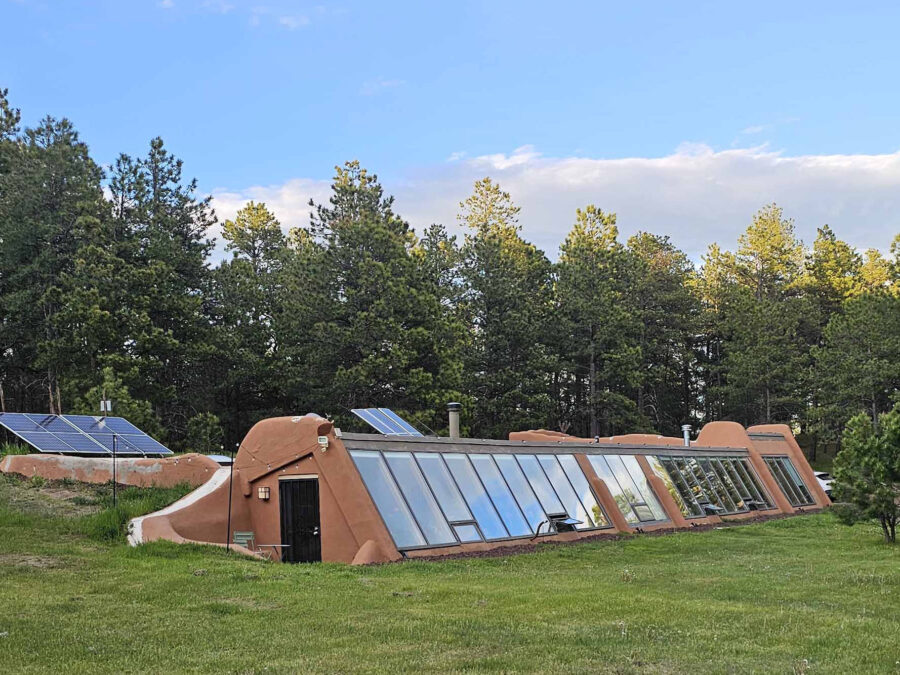
CULTURE


© Tian Fangfang

© Tian Fangfang
〈リバーサイド・パッセージ(Riverside Passage)〉は、上海の石炭埠頭に残されたコンクリート壁とそこに芽生えた木々を活用することで、開発されゆくウォーターフロントにかつての産業活動の歴史を残す、開放的な回廊を備えた建築です。
「瓦礫と木々による発展の歴史を表す風景」と、「黄浦江(こうほこう)沿いの開発された風景」という異なる性格の景観を壁の内外で見せ、片流れ屋根や回廊の高さの違いがそれぞれの風景との距離やスケールの違いを暗示しています。上海を拠点に活動するアトリエ・デスハウス(Atelier Deshaus)が設計しました。
(以下、Atelier Deshausから提供されたプレスキットのテキストの抄訳)

© Tian Fangfang
埠頭に残された壁とそこに生える木々が共存する廃墟的な景観
〈リバーサイド・パッセージ〉が建設された場所は、以前は旧楊浦ガス工場につながる輸送用の石炭積み出し埠頭として使われていた。
長さ約90m、高さ約4mの鉄筋コンクリートの壁は、荷揚げされた石炭が川に流れ込むのを防ぐために築かれた。しかし石炭埠頭が使われなくなって以来、この長い壁は放置され、静かに老朽化した存在となっていった。

Before renovation © Atelier Deshaus

Before renovation © Atelier Deshaus
長い壁は元々は2つあったが、川沿いの壁は取り壊されて久しい。残された壁に沿って、石炭の残骸や壊れたコンクリート、埃で覆われた隙間に落ちた種が芽を出し、大きな木へと成長し、今では長い壁と共存している。
木々と残された壁による廃墟特有の風景は、近年の上海における洗練された都市再開発で急速に失われつつある中で、特別な意味をもつ景観となった。

© Tian Fangfang

© Tian Fangfang
工業用の物流空間から都市の公共空間へと変貌を遂げるウォーターフロント再生プロジェクトとして、過去半世紀にわたる上海の旺盛な産業活動の証である既存の景観の維持が重要であることは言うまでもない。
地質学的な意味合いをもつ、長く堅固なコンクリート壁を基礎とした〈リバーサイド・パッセージ〉は、壁と埠頭の間をつなぎつつ野生の木々を横切る傾斜した橋、高架の開放的な回廊、休憩用のパビリオンとしても機能する。

© Tian Fangfang
「瓦礫と木々が織りなす発展の歴史」と「川沿いの開発された風景」という、内外で異なる景観を見せる壁
壁の内側と外側の空間を区切るように、片勾配の屋根がデザインされている。内陸側には静かな庭を眺める地上レベルの回廊があり、外側には上海の開発された景観を象徴する黄浦江を見下ろす方持ちの回廊がある。
一方は地上に、もう一方は浮遊した回廊は、距離や眺める風景の違いによるスケールの変化を暗示している。

© Tian Fangfang

© Tian Fangfang
石炭の荷揚げとしての機能を失った埠頭は、今では滑らかなローラースケート場へと磨き上げられた。このローラースケート場はもち上げられた回廊とともに、より身近な空間的な対話を形成している。
地面、壁、そして挿入された構造物が新たなアンサンブルとして統合され、そこで人々は好きなように立ち止まったり、通り抜けたりすることができる。

© Tian Fangfang

© Tian Fangfang
都市のさまざまな時代の景観を切り取るフレームとしての構造物
こうして、かつての石炭埠頭は、都市を散策する人々のための場所となった。
細長い柱と梁の鉄骨構造物は、都市景観を切り取るフレームとしても機能し、かつてのガス工場の煙突、明るい色のクレーン、泥に埋もれ潮の流れに何度も洗われたコンクリートブロック、川の向こうにそびえる高層ビル、遠く離れた橋など、過ぎ去ったさまざまな時代の証人をフレームに収める。

© Tian Fangfang

© Tian Fangfang

© Tian Fangfang
以下、Atelier Deshausのリリース(英文)です。
Riverside Passage
Project Information
Location: 2524 Yangshupu Rd, Yangshupu Gas Factory Wharf, Yangpu, Shanghai
Planning: Atelier Z+, Atelier Liu Yuyang Architects, Atelier Deshaus
Architects: Atelier Deshaus
Structural Design: AND Office
Design Team: Liu Yichun, Shen Wen, Chan Hiongai
Coordination: Zhang Bin, Wang Weijie, Wang Jiaqi, Guo Yifeng
Landscape Consultant: YIYU Design, Laurent Landscape&Architects Firm
Floor Area: 268 sqm
Design Period: 2018.03-2018.11
Completion: 2019.10
Photography: Tian FangfangProject Description
The site of the Riverside Passage had been a wharf for unloading coal as part of the transport system for the nearby Yangpu Gas Plant. The approximately 90 meters long and 4 meters high reinforced concrete wall along the wharf was built to prevent the unloaded coal from slipping into the river. Since losing its function for transporting coal, the long wall’s existence became one of silence and abandonment. Originally, there had been two walls. The one along the river has long been dismantled. Along the remaining wall, seeds have since landed in the gaps formed by the coal debris, broken concrete, and dust, have sprouted and grown into sizable trees, and are now coexist and complement the long wall. The trees and the abandoned wall form an ambiance that is embodied with meaning accorded to ruins. Such landscapes, however, are rapidly vanishing in Shanghai’s recent bout of urban renewals that are too polished for such ambience. For a renewal project to create a waterfront public space from a logistical space for industrial use, it is important to preserve this existing ambience, as is bears witness to the sophisticated industries in Shanghai of the past half century.
The new proposal takes the long stolid concrete wall as a basis for development, as a foundation with geological meaning. It serves as the basis, for a sloping bridge connecting the flood-control wall and the gap of the wharf, traversing the wild vegetation. It serves as a basis for an elevated open passage, as well as for a resting pavilion. A single-pitched roof demarcates the inside and outside of the wall. Facing inside a garden of ruins between the gap of the wharf and the shore is a passage on the ground. Facing outside is a cantilevered corridor overlooking the river. Where one is grounded, the other is floating, suggesting the scalar and distance differences in perception.
The wharf no longer used for coal-unloading is now polished into a roller-skating rink, forming, together with the cantilevered passage, a spatial dialogue in closer proximity. The ground, the body of the wall, and the inserted structures create a new ensemble. Visitors may linger at will or move on through. The former coal wharf, thus, has become a place for urban flaneurs. The slender post-and-beam steel structures perform as a series of frames for the urban views, that when visitors move through, they begin to frame the different passing epochs – the former gas plant’s chimney, the bright-colored cranes, tide-washed concrete blocks embedded in mud, buildings rising across the river, and the bridges in the distance.
「Riverside Passage」Atelier Deshaus 公式サイト
http://www.deshaus.com/En/Script/detail/catid/8/id/31.html



![新街区「麻布台ヒルズ」11/24開業、商業施設、オフィス、ウェルネス、ギャラリー、グリーンを複合・集約したコンパクトシティ[内覧会レポート]](https://magazine-asset.tecture.jp/wpcms/wp-content/uploads/2023/11/24095938/20231124azabudai-hills_press02-900x600.jpeg)




